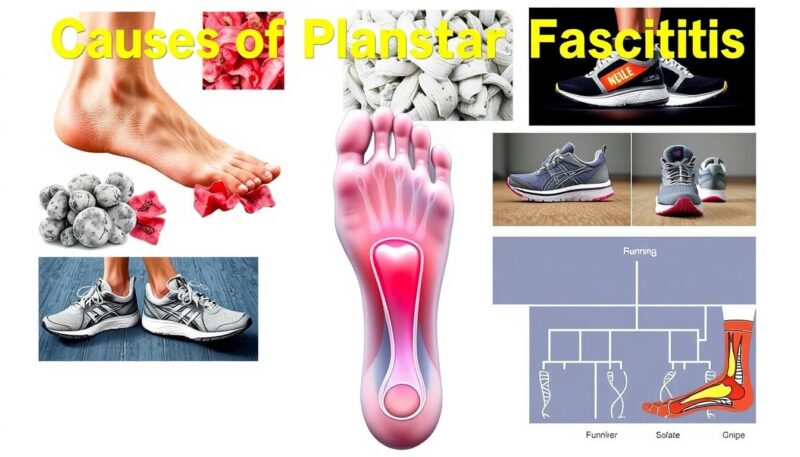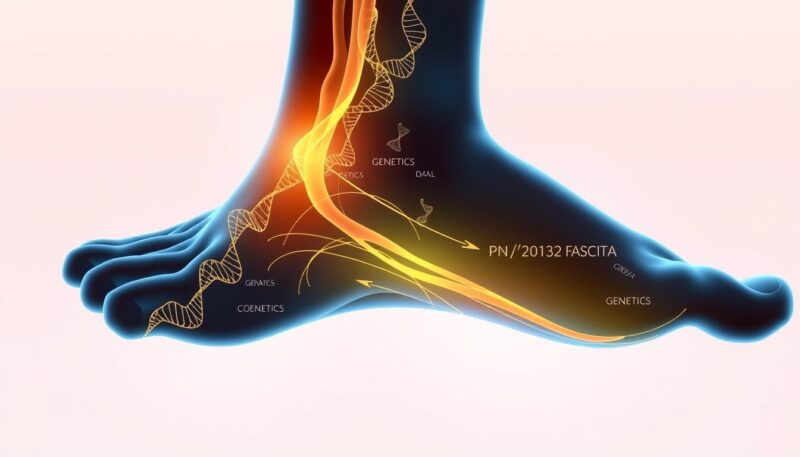As you consider the potential causes of plantar fasciitis, you may wonder if genetic factors play a role in its development. Plantar fasciitis genetic factors, hereditary plantar fasciitis, and genetic links to plantar fasciitis are all important considerations when understanding this condition. Research suggests that certain genetic traits can contribute to the development of plantar fasciitis, which affects the heel and bottom of the foot, causing pain and discomfort.
With around 10%-20% of the general population having flat feet, a homozygous recessive genetic trait that can lead to pronation, it’s essential to explore the potential genetic links to plantar fasciitis. You may be at risk if you have a family history of flat feet or other foot problems, as having one parent with flat feet can increase your chances of having flat feet by about 50%.
Understanding the potential genetic links to plantar fasciitis can help you take proactive steps to prevent or manage the condition. By recognizing the role of genetic factors, such as hereditary plantar fasciitis, you can work with your healthcare provider to develop a personalized plan to address your specific needs and reduce your risk of developing plantar fasciitis.
Understanding the Genetic Link to Plantar Fasciitis
Research has shown that genetic factors can contribute to the development of plantar fasciitis. If you have a family history of plantar fasciitis, you may be more likely to develop the condition due to your genetic predisposition to foot pain. Studies have identified specific genetic loci associated with plantar fascial disorders, and inherited genetic traits can affect foot structure and function.
A genetic predisposition to foot pain can increase your risk of developing plantar fasciitis. For example, individuals with a family history of flat feet or other foot conditions may be more likely to develop plantar fasciitis. Certain genetic traits can affect the structure and function of the foot, making it more prone to injury and conditions such as plantar fasciitis. The role of DNA in foot structure is complex, and plantar fasciitis and DNA are closely linked.
What Research Says About Hereditary Factors
Studies have found that family history raises the likelihood of developing plantar fasciitis. Twin studies reveal a higher concordance rate in identical twins, indicating a stronger genetic influence. Genetic markers and variants associated with musculoskeletal conditions are being identified, and certain genetic variations in inflammatory pathways increase the risk of chronic inflammation in the plantar fascia.
The Role of DNA in Foot Structure
DNA plays a crucial role in determining foot structure and function. Genetic traits can affect the shape and size of the foot, as well as the strength and flexibility of the muscles and tendons. Plantar fasciitis family history can increase the risk of developing the condition, and understanding the genetic link to plantar fasciitis can help you take proactive steps to prevent it.
Common Genetic Traits Associated with Plantar Fasciitis
Some common genetic traits associated with plantar fasciitis include flat feet, high arches, and other foot abnormalities. These traits can increase the risk of developing plantar fasciitis, especially if you have a family history of the condition. Understanding your genetic predisposition to foot pain can help you take steps to prevent plantar fasciitis and reduce your risk of developing the condition.
| Genetic Trait | Risk of Plantar Fasciitis |
|---|---|
| Flat Feet | Increased |
| High Arches | Increased |
| Family History of Plantar Fasciitis | Increased |
Risk Factors That Run in Families
When considering the causes of plantar fasciitis, it’s essential to examine the genetic links to plantar fasciitis. Certain risk factors can run in families, including genetic traits that affect foot structure and function. For example, individuals with a family history of flat feet or other foot conditions may be more likely to develop plantar fasciitis.
Some of the key risk factors for plantar fasciitis that can be influenced by genetic traits include:
- Flat feet or low arches
- High arches
- Obesity or higher body mass index (BMI)
- Low flexibility in the Achilles tendon or calf muscles
- Certain types of exercise or physical activity
Additionally, certain types of workers who spend a significant amount of time on their feet, such as food service workers, teachers, and medical professionals, are at an increased risk for developing plantar fasciitis due to repeated stress and overuse to the heels and bottoms of their feet. 
Understanding the genetic links to plantar fasciitis and the risk factors that run in families can help individuals take preventative measures to reduce their likelihood of developing the condition. By being aware of the causes of plantar fasciitis and taking steps to mitigate these risk factors, individuals can reduce their risk of developing this painful and debilitating condition.
Is Plantar Fasciitis Genetic? The Scientific Evidence
Research suggests that plantar fasciitis genetic factors can contribute to the development of the condition. While there is no specific “plantar fasciitis gene,” certain genetic traits can increase the risk of developing the condition. For instance, individuals with a family history of foot problems are more likely to develop plantar fasciitis.
Studies have identified genetic markers associated with foot inflammation, which can contribute to the development of plantar fasciitis. Additionally, genetic traits can influence foot structure and function, making it more prone to injury and conditions such as plantar fasciitis. Hereditary plantar fasciitis can be a significant factor in the development of the condition, and understanding the genetic link can help individuals take preventive measures.
Studies on Family History and Foot Problems
Several studies have investigated the correlation between family history and the development of plantar fasciitis. These studies have found that individuals with a family history of foot problems are more likely to develop plantar fasciitis. This suggests that plantar fasciitis genetic factors can play a significant role in the development of the condition.
Genetic Markers for Foot Inflammation
Genetic markers associated with foot inflammation can increase the risk of developing plantar fasciitis. These markers can contribute to the development of inflammation in the plantar fascia, leading to pain and discomfort. Understanding the genetic markers associated with foot inflammation can help individuals take preventive measures to reduce their risk of developing plantar fasciitis.

How Your DNA Influences Foot Structure
Your DNA can influence the structure and function of your feet, making you more prone to developing plantar fasciitis. For example, genetic traits can affect the shape and size of the foot, as well as the structure of the plantar fascia. Understanding how your DNA influences foot structure can help you take preventive measures to reduce your risk of developing plantar fasciitis.
Conclusion: Managing Your Genetic Predisposition to Plantar Fasciitis
While your genetic predisposition may contribute to your risk of developing plantar fasciitis, there are steps you can take to manage this condition. Maintaining a healthy weight, wearing supportive footwear, and regularly stretching and strengthening your foot muscles can help mitigate the impact of your genetic predisposition to foot pain. Additionally, if you have a family history of foot problems or genetic traits that affect foot structure and function, it’s important to consult with a podiatrist or physical therapist to develop a personalized treatment plan.
Early intervention and proactive management are key to preventing long-term damage and improving treatment outcomes. By understanding your DNA and its influence on your foot health, you can take a proactive approach to managing your genetic predisposition to plantar fasciitis and reduce the impact of this painful condition.
